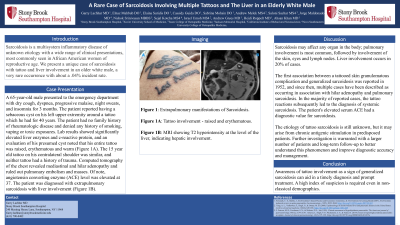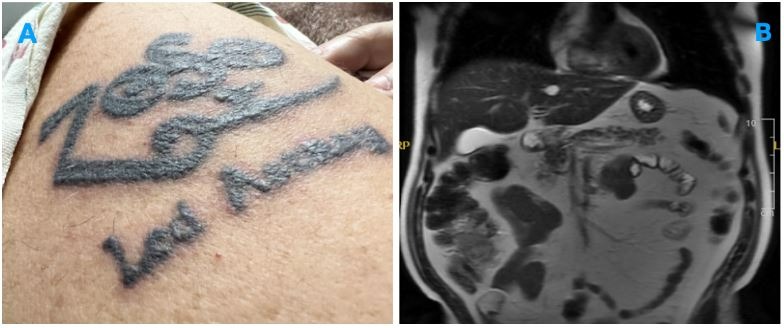Back


Poster Session D - Tuesday Morning
Category: Liver
D0533 - A Rare Case of Sarcoidosis Involving Multiple Tattoos and Organ Systems in an Elderly White Male
Tuesday, October 25, 2022
10:00 AM – 12:00 PM ET
Location: Crown Ballroom

Has Audio

Garry Lachhar, MD
Stony Brook Southampton Hospital
Southampton, NY
Presenting Author(s)
Garry Lachhar, MD, Elnaz Mahbub, DO, Elaina Suridis, DO, Cassidy Guida, DO, Sabrina Mohsin, DO, Andrew Melek, MS, Saloni Sachar, MS, Jorge Maldonado, MS, Nishok Srinivasan, MS, Sejal Kotecha, MS, Israel Umoh, MS, Heidi Roppelt, MD, Ahsan Khan, MD
Stony Brook Southampton Hospital, Southampton, NY
Introduction: Sarcoidosis is a multisystem inflammatory disease of unknown etiology with a wide range of clinical presentations, most commonly seen in African American women of reproductive age. We present a unique case of sarcoidosis with tattoo and liver involvement in an older white male, a very rare occurrence with about a .04% incident rate.
Case Description/Methods: A 65-year-old male presented to the emergency department with dry cough, dyspnea, progressive malaise, night sweats, and insomnia for 3 months. The patient reported having a sebaceous cyst on his left upper extremity around a tattoo which he had for 40 years. The patient had no family history of rheumatologic disease and denied any history of smoking, vaping or toxic exposures. Lab results showed significantly elevated liver enzymes and c-reactive protein, and an evaluation of his presumed cyst noted that his entire tattoo was raised, erythematous and warm (Figure 1A). The 15 year old tattoo on his contralateral shoulder was similar, and neither tattoo had a history of trauma. Computed tomography of the chest revealed mediastinal and hilar adenopathy and ruled out pulmonary embolism and masses. Of note, angiotensin converting enzyme (ACE) level was elevated at 37. The patient was diagnosed with extrapulmonary sarcoidosis with liver involvement (Figure 1B).
Discussion: Sarcoidosis may affect any organ in the body; pulmonary involvement is most common, followed by involvement of the skin, eyes and lymph nodes. Liver involvement occurs in 20% of cases. The first association between a tattooed skin granulomatous complication and generalized sarcoidosis was reported in 1952, and since then, multiple cases have been described as occurring in association with hilar adenopathy and pulmonary sarcoidosis. In the majority of reported cases, the tattoo reactions subsequently led to the diagnosis of systemic sarcoidosis. The patient's elevated serum ACE had diagnostic value for sarcoidosis. The etiology of tattoo sarcoidosis is still unknown, but it may arise from chronic antigenic stimulation in predisposed patients. Further investigation is warranted with a larger number of patients and long-term follow-up to better understand this phenomenon and improve diagnostic accuracy and management.
Awareness of tattoo involvement as a sign of generalized sarcoidosis can aid in a timely diagnosis and prompt treatment. A high index of suspicion is required even in non-classical demographics.

Disclosures:
Garry Lachhar, MD, Elnaz Mahbub, DO, Elaina Suridis, DO, Cassidy Guida, DO, Sabrina Mohsin, DO, Andrew Melek, MS, Saloni Sachar, MS, Jorge Maldonado, MS, Nishok Srinivasan, MS, Sejal Kotecha, MS, Israel Umoh, MS, Heidi Roppelt, MD, Ahsan Khan, MD. D0533 - A Rare Case of Sarcoidosis Involving Multiple Tattoos and Organ Systems in an Elderly White Male, ACG 2022 Annual Scientific Meeting Abstracts. Charlotte, NC: American College of Gastroenterology.
Stony Brook Southampton Hospital, Southampton, NY
Introduction: Sarcoidosis is a multisystem inflammatory disease of unknown etiology with a wide range of clinical presentations, most commonly seen in African American women of reproductive age. We present a unique case of sarcoidosis with tattoo and liver involvement in an older white male, a very rare occurrence with about a .04% incident rate.
Case Description/Methods: A 65-year-old male presented to the emergency department with dry cough, dyspnea, progressive malaise, night sweats, and insomnia for 3 months. The patient reported having a sebaceous cyst on his left upper extremity around a tattoo which he had for 40 years. The patient had no family history of rheumatologic disease and denied any history of smoking, vaping or toxic exposures. Lab results showed significantly elevated liver enzymes and c-reactive protein, and an evaluation of his presumed cyst noted that his entire tattoo was raised, erythematous and warm (Figure 1A). The 15 year old tattoo on his contralateral shoulder was similar, and neither tattoo had a history of trauma. Computed tomography of the chest revealed mediastinal and hilar adenopathy and ruled out pulmonary embolism and masses. Of note, angiotensin converting enzyme (ACE) level was elevated at 37. The patient was diagnosed with extrapulmonary sarcoidosis with liver involvement (Figure 1B).
Discussion: Sarcoidosis may affect any organ in the body; pulmonary involvement is most common, followed by involvement of the skin, eyes and lymph nodes. Liver involvement occurs in 20% of cases. The first association between a tattooed skin granulomatous complication and generalized sarcoidosis was reported in 1952, and since then, multiple cases have been described as occurring in association with hilar adenopathy and pulmonary sarcoidosis. In the majority of reported cases, the tattoo reactions subsequently led to the diagnosis of systemic sarcoidosis. The patient's elevated serum ACE had diagnostic value for sarcoidosis. The etiology of tattoo sarcoidosis is still unknown, but it may arise from chronic antigenic stimulation in predisposed patients. Further investigation is warranted with a larger number of patients and long-term follow-up to better understand this phenomenon and improve diagnostic accuracy and management.
Awareness of tattoo involvement as a sign of generalized sarcoidosis can aid in a timely diagnosis and prompt treatment. A high index of suspicion is required even in non-classical demographics.

Figure: Figure 1: Extrapulmonary Sarcoidosis manifestations. Figure 1A: Tattoo. Figure 1B: Liver MRI
Disclosures:
Garry Lachhar indicated no relevant financial relationships.
Elnaz Mahbub indicated no relevant financial relationships.
Elaina Suridis indicated no relevant financial relationships.
Cassidy Guida indicated no relevant financial relationships.
Sabrina Mohsin indicated no relevant financial relationships.
Andrew Melek indicated no relevant financial relationships.
Saloni Sachar indicated no relevant financial relationships.
Jorge Maldonado indicated no relevant financial relationships.
Nishok Srinivasan indicated no relevant financial relationships.
Sejal Kotecha indicated no relevant financial relationships.
Israel Umoh indicated no relevant financial relationships.
Heidi Roppelt indicated no relevant financial relationships.
Ahsan Khan indicated no relevant financial relationships.
Garry Lachhar, MD, Elnaz Mahbub, DO, Elaina Suridis, DO, Cassidy Guida, DO, Sabrina Mohsin, DO, Andrew Melek, MS, Saloni Sachar, MS, Jorge Maldonado, MS, Nishok Srinivasan, MS, Sejal Kotecha, MS, Israel Umoh, MS, Heidi Roppelt, MD, Ahsan Khan, MD. D0533 - A Rare Case of Sarcoidosis Involving Multiple Tattoos and Organ Systems in an Elderly White Male, ACG 2022 Annual Scientific Meeting Abstracts. Charlotte, NC: American College of Gastroenterology.
